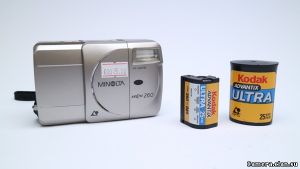Most cameras support 3 exposure formats:
The C and P formats are formed by cropping, each format can be selected via the camera (with the exception of some disposable cameras) at any time for use with the format. The H format is the original format. Every single image on the developed film has this format, the print format is just information written by the camera onto magnetic storage on the film - which is used by the printing equipment to crop the picture appropriately. The approach of modern digital single lens reflex camera bodies in the heydays of APS film made it common to use the terms APS format or APS size for the size of DSLR image sensors. This was because they were smaller than 35mm film's 24×36mm format. But there were different size variants prefered by different camera makers:
The magnetic data storage on the APS film is made possible by a transparent magnetic coating of the film's back. Data for certain purposes is stored there on several tracks. This offers a unique set of advantages:
Some APS-film-viewers offer the possibility of changing the information on this magnetic storage, for example to switch the print format, or to add information for a slideshow on that viewing device. The exposure data is useful for corrections of underexposure or matters like that by the photo laboratory. It's also used for removing a film from a camera for putting it back into it later. Thus a photographer can switch from the color film he actually uses to a black and white film for some exposures, and vice versa, until both films are full. The additional mechanical marker in the film cartridge shows when a film is full. This marker shows whether the film is empty, in use, full, or developed. The exposure numbers are stored twice, once as magnetic data, and another time enlighted on the film which has just one perforation with two holes per image. The film's basic material is refined polyethylene naphthalate (A-PEN) foil, and its film emulsion is improved compared to pre-1996 35mm film emulsions. Read More: http://camera-wiki.org/wiki/APS_film Source: http://camera-wiki.org/wiki/APS_film | |||
|
| |||
| Views: 475 | | | |||
| Total comments: 0 | |
 The Advanced Photo System (or APS) was introduced in 1996 as an alternative to or even as modern replacement for the still-popular 35mm format. The "IX240" film cartridges are optimized for fully automatic film load, enclosing the 24mm wide film completely when not in use. The film is even put back into its cartridge and returned to the user after it has been developed. Kodak stopped manufacturing APS film in 2011, Fujifilm also stopped manufacturing APS film in July, 2011 and stock had depleted by 2012.
The Advanced Photo System (or APS) was introduced in 1996 as an alternative to or even as modern replacement for the still-popular 35mm format. The "IX240" film cartridges are optimized for fully automatic film load, enclosing the 24mm wide film completely when not in use. The film is even put back into its cartridge and returned to the user after it has been developed. Kodak stopped manufacturing APS film in 2011, Fujifilm also stopped manufacturing APS film in July, 2011 and stock had depleted by 2012.